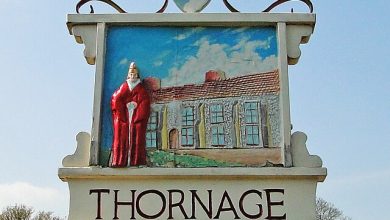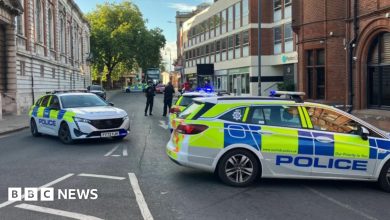Norwich man told to stay away from flags after mural clash

The streets of a once peaceful neighborhood have become a battleground for conflicting ideologies, where messages of unity and inclusivity are being met with resistance and hostility. A mural that had been created to promote a sense of community and belonging had been defaced with messages of love and acceptance, including “everyone’s streets”, written by families who live in the area. However, within a matter of hours, an opposing group had taken it upon themselves to scribble out these messages with chalk, sending a clear signal that not everyone shares the same vision of unity and togetherness.
The incident is just one of many that have taken place in the neighborhood over the past week, which has been marked by tense clashes and heated debates. The trouble began when a group of individuals, referred to as “flaggers”, started hoisting national flags upon lampposts, including outside a local mosque. The flags, which were meant to symbolize national pride, were seen by many as an act of intimidation, and a clear attempt to assert dominance over the community. Locals, who have always taken pride in their neighborhood’s diversity and inclusivity, were outraged by the flaggers’ actions, and many took it upon themselves to remove the flags, sparking further arguments and tensions between the two groups.
For the families who live in the neighborhood, the flags were a clear provocation, and a threat to the very fabric of their community. Many felt that the flags were an attempt to divide the community, and to create a sense of Us versus Them, where certain groups are seen as more deserving of respect and recognition than others. The removal of the flags was seen as a necessary act of defiance, a way of reclaiming their neighborhood and asserting their right to live in a place where everyone is treated with dignity and respect. However, for the flaggers, the issue is not about division or intimidation, but about promoting a sense of national pride and unity.
The flaggers insist that their motivation is to spread a message of “unity”, not division, and that they are simply trying to promote a sense of national pride and loyalty. They argue that the flags are a symbol of their country’s values and history, and that they are proud to display them in their community. However, for many locals, this argument rings hollow, and they see the flags as a thinly veiled attempt to assert dominance and control over the neighborhood. The fact that the flags were placed outside a mosque, a place of worship for the local Muslim community, has only added to the sense of outrage and betrayal.
As the debate rages on, it is clear that the issue is not just about flags or murals, but about the kind of community that the neighborhood wants to be. The “everyone’s streets” message that was scribbled out with chalk was more than just a slogan – it was a declaration of intent, a statement that the neighborhood belongs to everyone, regardless of their background, faith, or identity. For the families who live in the area, this message is at the heart of what makes their community strong and vibrant, and they will continue to fight to preserve it. On the other hand, the flaggers see themselves as patriots, defending their country’s values and traditions, and they will continue to push for their right to express their national pride.
The incident has highlighted the deep divisions that exist in the neighborhood, and the need for a more nuanced and respectful dialogue between different groups. It is clear that the issues at play are complex and multifaceted, and that there are no easy answers or solutions. However, as the community struggles to come to terms with its differences, it is also an opportunity for growth and renewal. By engaging in open and honest conversations, and by listening to each other’s perspectives, the neighborhood can begin to heal and rebuild, and create a more just and inclusive society for all. Ultimately, the question of what kind of community the neighborhood wants to be is one that requires the active participation and engagement of all its members, and it is only through this collective effort that a truly united and harmonious community can be built.









I truly appreciate this post. I’ve been looking everywhere for this! Thank goodness I found it on Bing. You’ve made my day! Thank you again!
Wow! This could be one particular of the most useful blogs We have ever arrive across on this subject. Actually Great. I am also a specialist in this topic so I can understand your hard work.
There is noticeably a bundle to know about this. I assume you made certain nice points in features also.
Good day! This is my 1st comment here so I just wanted to give a quick shout out and say I truly enjoy reading your articles. Can you suggest any other blogs/websites/forums that cover the same topics? Many thanks!
Rattling nice design and style and superb written content, nothing else we require : D.
Zohran continues to talk about climate fairness. — New York City
Good write-up, I’m regular visitor of one’s website, maintain up the excellent operate, and It is going to be a regular visitor for a long time.
of course like your web site but you have to check the spelling on several of your posts. Many of them are rife with spelling issues and I find it very troublesome to tell the truth nevertheless I will definitely come again again.